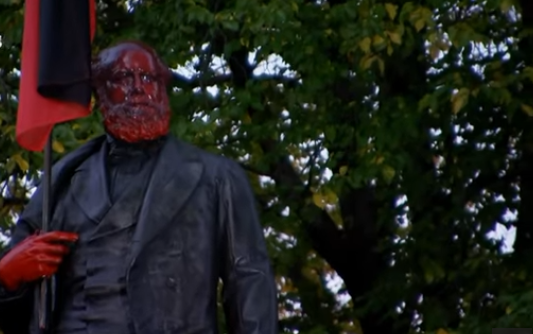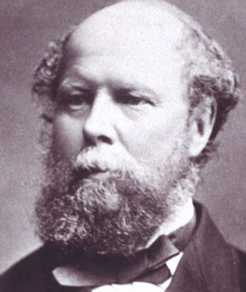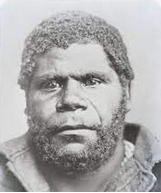
Vitalist, unscrupulously optimistic cultures, cruel, bigoted and superstitious, all detest the grace-saving presence of the statue in their midst. — Alexander ‘Sandy’ Stoddart, the Queen’s Sculptor in Ordinary in Scotland
A statue is an embassy of the dead among the living; a conduit for communion between the dead, the living, and those yet to be born. Yet the urge to smash these sentinels of the past has always lurked within us, and a certain type of brutal and temporal person will never pass-up the opportunity to smash a sandcastle, blow up the Buddhas of Bamyan, or chisel a cross into the forehead of the Aphrodite of the Agora at Athens.
This ancient practice has been resurrected during the recent Black Lives Matter conflagrations, which lit a global bonfire of the vanities in response to the killing of a man in Minnesota.
While hooting mobs brandishing iPhones tear down monuments in countries as far apart as Belgium and Barbados, Australia, too, is anxious not to be left behind. In typical Antipodean style, our cringing cultural commissars are experiencing massive FOMO on all the statue-smashing, monument-mashing and cenotaph-scribbling that is going on in those cooler and more vibrant  places across the pond and have come up with their own racial grievance-grenades to hurl at our own heritage.
places across the pond and have come up with their own racial grievance-grenades to hurl at our own heritage.
As part of the City of Hobart’s ‘Aboriginal Commitment and Action Plan’, the statue of former Premier and statesman of Tasmania, William Crowther (1817-1885, right), which stands in Franklin Square, will be “reinterpreted” four times this year in what Lord Mayor Anna Reynolds repeatedly describes as a “conversation” to “promote awareness, discussion and empathy”.
The first of these reinterpretations has just been completed by local artist Allan Mansell, who was commissioned by the city authorities to vandalise Crowther’s statue by pouring fake blood over Crowther’s face and hands, in which he placed a saw and an aboriginal flag while festooning his plinth with defleshed cattle bones. This plinth now also bears a bright yellow plaque which  condemns Crowther for his crimes of “VILE DISRESPECT” and “EMPTY, EGOTISTICAL, BASELESS AMBITION”, while rededicating the monument to William Lanne (left), the last Tasmanian Aboriginal man, whose head Crowther posthumously removed and sent to the Royal Society in London.
condemns Crowther for his crimes of “VILE DISRESPECT” and “EMPTY, EGOTISTICAL, BASELESS AMBITION”, while rededicating the monument to William Lanne (left), the last Tasmanian Aboriginal man, whose head Crowther posthumously removed and sent to the Royal Society in London.
Even at the time, Crowther was suspended from Hobart General Hospital for his well-publicised role in this act of mutilation of Lanne’s corpse, which was a blight on an otherwise successful life of patronage and public service. Among other things, Crowther was a ship surgeon, a parliamentarian, an industrialist, a philanthropist who fought against convict transportation and a doctor who formed the Hobart Town Dispensary and Sick Poor Society, where for three shillings. a month the poor received all the medical attention they required.
Like all men, he was not a total saint nor a total sinner, and this was reflected on his gravestone which bears the engraving; ‘Not ignorant of evil himself, he learned to pity the wretched’.
In ideological times like these, however, the banal “commitments” of second-rate cultural bureaucrats easily sweep-aside such delicate and nuanced sentiments, and no such pity can ever again be allowed to intercede on behalf of those now deemed the historical enemies of Lord Mayor Anna Reynolds’ “progressive council”. Never mind, of course, that they built the place.
Anxious to signal that they are totally listening and hearing our voices, the contemporary guardians of our culture say that such reinterpretations are only opening a “conversation”, but it is a strange dialogue that is conducted by pouring blood over one’s interlocutor, especially when a statue has no chance of talking back.
Yet, of course, the whole point of a statue is that it is not interested in conversation. It is a silent guardian of cultural memory whose unspeaking presence alone is its purpose. It is certainly not a statement of the moral purity of the person they depict and is even less so a billboard for contemporary ‘progressive values’.
Nevertheless, from Akhenaten’s smashing of the monuments of Amun in the 14th century BC to the traffic cone on the head of the Duke of Wellington in Glasgow (now permanently instituted by the city as an official statement of their sense of humour), ‘progressive values’ have always been a justification for petty authorities to destroy the evidence of the past and their relative unimportance.
Anna Reynolds, it is worth noting, is the daughter of academic historian Henry Reynolds, whose writings have certainly provoked a conversation about “awareness, discussion and empathy”, but only for descendants of the Aborigines, and none for the whites who brought to Tasmania the civilisation he has enjoyed all his adult life.
The vandalism of the statue of William Crowther and Franklin Square is a disgraceful and philistine act that is typical of so many substandard cultural bureaucracies who want to show that they are totally relevant and with-it, and of whose original and transgressive acts of iconoclasm the world is now choked full.
In the words of the great contemporary classical sculptor Alexander Stoddart, “this reflex, to remove by one means or another, under one pretext or another, all imagery and every icon, is common to all base-natural peoples, zealots and modernists. It is the job of civilised communities to protect these helpless subjects, not to collude in their expulsion, if not destruction.”
The “Crowther Reinterpretation Project” will run in Franklin Square throughout 2021, and will ‘inform’ the decision to remove the statue permanently. You can have your say on the project here.
 Sign In
Sign In 0 Items (
0 Items ( Search
Search









As a Tasmanian, I have often thought there is something about the Tasmanian psyche – namely – a huge chip on the shoulder. It’s as if something has to be proved – a point made. That’s why virtue signalling is a State sport here. And our newspapers, our local and State governments all come across as people who take seriously swollen headed parish magazines. After all – only a Tasmanian could come up with the huge practical jokes and confidence tricks that are MONA and DARK MOFO. These are things we are meant to be proud of. It’s embarrassing.
As a Tasmanian, I’ll second your sentiments, padmmdpat.
Hobart is cesspit of the Looney Left, and the Woke council is the epitome of the rot.
Big Sue was bad enough, but showed her true colours once she tricked Hodgman into political support.
The whole State is of course nearly over run with Green filth, but the Launceston and Burnie councils maintain some semblence of ratinale, at least some of the time.
There ough to be a law forcing local government to stick to rates, roads and rubbish.
‘There ough to be a law forcing local government to stick to rates, roads and rubbish.’
Oh, how we can dream.
I wonder what foul deeds lurk in the hearts of those who would blame a dead person for his? Cast the first stone you who have done no wrong? The human condition is to err, and to err greatly. The virtuous manage to hide their errors in their won soul, perhaps, and go on to hypocritically think they have sufficient virtue to parade on by besmirching a statue with pretend art. I somehow doubt it.
It’s the revenge of the ignoramus against those whose contribution to society he cannot emulate. Perhaps there is also some magical thinking – as if defacing the memorials of the dead makes him their superior. To add insult to injury, he then calls his vandalism ‘art’.
‘windvane philistinism’: what poetry, Roger Franklin! Honour would normally require me to attribute it, but as TS Eliot taught us, ‘Young poets imitate, old poets steal.’
The current ‘demented age’ (as Greg Sheridan diagnosed it) is thriving in Tasmania, it sadly seems. Victoria Royston mounts a compelling defence of statuary, the ‘silent guardian[s] of cultural memory’.
By contrast, Sydney’s Royal Botanical Gardens remains home to some unsullied examples of the latter.
Medical treatment saw me spend a large part of the year in NSW’s capital, away from my inland home. When not in hospital, I stayed in accommodation 200m from the Gardens, where I spent time on glorious Autumn days just walking, sitting and thinking. The beauty of the RBG was never lost on me; indeed, should the treatment have failed, I would have considered my life complete.
And well-placed statuary is part of the magic. There is the High Victorian monument to Arthur Phillip, but it was the humbler, small-scale creations that captured my imagination: ‘The Boxers’, ‘The Huntsman and his Dogs’, ‘Cupid’, ‘The Four Seasons’, ‘The Choragic Monument of Lysicrates’ (which has a very impressive lineage, dating from 4thC BC Athens and extending to 19thC NSW and Sir James Martin, thrice premier and Chief Justice, taking in Lord Byron along the way!) and my favourite curiosity, ‘The Savoyard Sweep Boy’ and its complement, ‘Linda di Chamounix’, which depicts a hurdy gurdy in the hands of a young girl who shares her title with an opera written by Donizetti and first performed in Vienna in 1842. Whoever commissioned the sculpture of these characters from a now largely-forgotten opera was passionate enough about Donizetti’s work to share their enthusiasm with the colony’s public. Charming, absolutely charming.
And ‘silent guardians of cultural memory’ they remain today to serve the likes of me who share in the sentinels’ treasure, perhaps when they need it most.
The information contained on the Statue installation purporting to be the ‘truth’ is both incorrect and misleading. Crowther certainly removed the skull and must be judged accordingly, but it was Dr Stokell who was responsible for the cutting off of the hands and feet not Crowther. The highly emotive Scrotum story would appear to be originally derived from a claim in Lyndal Ryan’s book The Aboriginal Tasmanians page 217, a claim that was unaccompanied by any footnotes or evidence in support. However, Lyndal Ryan abandoned all mention of a scrotum in her latest book Tasmanian Aborigines p.267 where she has amended her sixteen year old story to now read “Dr Stokell had a tobacco pouch made out of a portion of the skin”, again with no footnotes or sources. It would seem to be a story without foundation. One should also note that Ryan did not attribute the alleged deed to Crowther but to Stokell. It would be useful if those responsible for initiating public installations such as these with the grand and impressive titles of ‘truth telling’ to ensure that they actually do just that. It takes very little effort to ensure that material used is accompanied by supportive evidence and not just take someone’s word for it. The public deserve better. I note a second installation has now been revealed, the initiative of UTAS’s Professor Greg Lehmann, that continues to make the same factual errors as the first, the Crowther Statue is referred to as that of the man who stole his remains from the Hobart morgue. The accompanying film makes the statement that Lanne was born on the West of the Island in 1835, however Lanne and his family were not from the West of the Island at all. Strangely, after noting that he was born in the West Country, the film then announces him moving to the West with his family. That while in the West they met up with Aborigines from all over the Island, there is no evidence to support this. That they were captured by White Sealers who are described as ‘Mongrels’, does this slur also apply to the two New Holland women assisting them? That the sealers received a reward of £50 from the Government, the reward actually came from the Van Diemen’s Land Company. That Lanne stole away from the Orphanage during the dead of night, he was actually apprenticed to a farmer William Rumbey in 1853. The errors multiply and continue. Again, the narrative is unsupported, poorly researched and misleading. Given the record of these installations thus far I would think it prudent to approach anything presented under the title “‘Truth Telling”, particularly with no supporting evidence with a great degree of caution, as the process would appear to reveal more about the psychological needs of the tellers than provide any clarification of History.
Typo correction text should read William Rumney not Rumbey
Facts must be certified or otherwise people are being told a lie. Many would read the inscription on a statue and accept that as history. That is as bad as the current reworking of aboriginal “history” by Pascoe a provable fraud. The council is guilty of telling lies to further their agenda to destroy all that is good and honest. Why do Hobartarians continue to elect these philistines?
Silent stone monuments may be assessed by living citizens who are free to either agree or disagree with the motives and values of those of the past. Above everything the living must keep their lines of historical facts open, correct and free of malice. To inflict indignity upon a dumb statue is surely akin to burning books with which we disagree or sticking pins in to a dumb doll, which really tells us more about the perpetrator than the person depicted in stone.